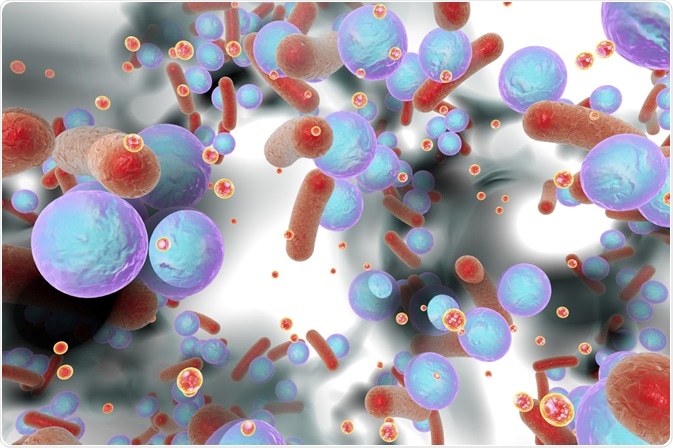Individual bacteria within a colony communicate with one another to produce higher-level effects in a process known as quorum sensing, appearing to allow bacterial colonies to respond to stresses or strive towards a goal.
 A biofilm of antibiotic-resistant bacteria. The small red spheres represent quorum-sensing molecules. Image Credit: Kateryna Kon/Shutterstock.com
A biofilm of antibiotic-resistant bacteria. The small red spheres represent quorum-sensing molecules. Image Credit: Kateryna Kon/Shutterstock.com
Quorum sensing allows bacterium within colonies to adjust their behavior in synchronicity, usually as a response to changes in species composition and local population density, with this orchestrated behavior significantly improving the longevity of the colony.
Examples of coordinated behaviors brought about via quorum sensing include the secretion of biofilm components, enhanced DNA transfer between bacterium, and the production of secondary metabolites and virulence factors.
How does quorum sensing begin?
Molecules that are released from bacteria to induce quorum sensing are known as autoinducers, and Gram-negative bacteria autoinducers are typically small molecules that can interact with the surface receptors of other Gram-negative bacteria, while Gram-positive bacteria employ oligopeptides that interact with transmembrane histidine sensor kinases.
When autoinducers interact with receptors on the surface of a bacterium they activate gene expression of the autoinducer in the second bacterium, quickly promoting a rise in the extracellular concentration of the molecule as the effect spreads to neighboring cells. This feedback loop is what allows a bacterial colony of sufficient size to begin quorum sensing, as below the minimum population level concentrations will not induce autoinducer secretion.
A number of autoinducer molecules are utilized simultaneously, depending on the species of bacteria, allowing the modulation of expression of a variety of genes by adjustment of the chemical signaling feedback and feedforward loops between the bacteria.
The formation of a biofilm is heavily associated with quorum sensing, encasing the colony within in an extracellular matrix of proteins, polysaccharides, and DNA that provides protection and a medium in which quorum sensing may occur. Interestingly, colonies within biofilms are not homogenous like a mixed culture in liquid, they rearrange over time to enhance nutrient acquisition, though not all species of bacteria react to autoinducers by forming a biofilm.
Pseudomonas aeruginosa, for example, responds to high concentrations of autoinducer by forming a high cell density biofilm, while Vibrio cholerae and Staphylococcus aureus form biofilms when in lower cell density populations, thus when populations and autoinducer concentrations rise biofilm formation is suppressed.
This has the intriguing result of enhancing the formation of biofilms in the latter two species in areas of high flow, such as adjacent to a passing bloodstream, as the local autoinducer concentration is continuously downregulated.
Some bacteria have demonstrated the ability to adapt between biofilms that tolerate flow or non-flow conditions intermittently, such as within the intestines or urethra. When there is no flow the colony is in quorum sensing mode, being paused when flow resumes and significantly lowers the extracellular autoinducer concentration. The effect of the concentration of autoinducer is also topographical and gradated, with outer areas that are exposed to flow demonstrating less autoinducer accumulation than bacteria located within an isolated region with little flow, within the intestinal crevices, for example, where the magnitude of autoinducer concentration is greatest at the deepest point. Regarding the species of bacteria discussed earlier, this has the effect of encouraging quorum sensing and biofilm formation in Pseudomonas aeruginosa within the crevices, and Vibrio cholerae outside.
Heterogeneity within the biofilm
As the concentration of autoinducer in a medium follows a gradient then not all bacteria in a colony begin quorum sensing simultaneously, meaning that there is heterogeneity in that some cells are in “sensing mode”, producing autoinducers, while others are not. In a mature biofilm, all bacteria are producing autoinducers, and the culture becomes homogenous in this regard.
Putisolvins are sometimes secreted by bacteria at this stage to disperse the biofilm and spread the bacteria to new colonies, but a great deal of phenotypic heterogeneity is induced in the bacteria before dispersal. As autoinducer production begins to downregulate after a certain concentration threshold is reached then some bacteria cease quorum sensing and act independently, while others in the colony continue producing autoinducers.
This can result in distinct bacterial populations within a colony, where a small number persist in autoinducer production to support the colony, while others gain the fitness advantage of not engaging in autoinducer production, allowing them to engage in other metabolic activities. Mutants can also arise that exploit the metabolic products of neighboring bacteria without contributing to quorum sensing themselves.
Host factors can also interfere with quorum sensing, as can the autoinducers of other species of bacteria. Staphylococcus aureus and Pseudomonas aeruginosa are both common wound infections, and the two can co-exist synergistically under such conditions.
Curiously, however, under laboratory conditions, Pseudomonas aeruginosa eliminates Staphylococcus aureus as it produces autoinducers that inhibit the growth of the competitor. Within a wound host factors such as serum albumin sequester the Pseudomonas aeruginosa autoinducers, allowing the two species to coexist and resulting in higher orders of drug resistance.
References:
Further Reading